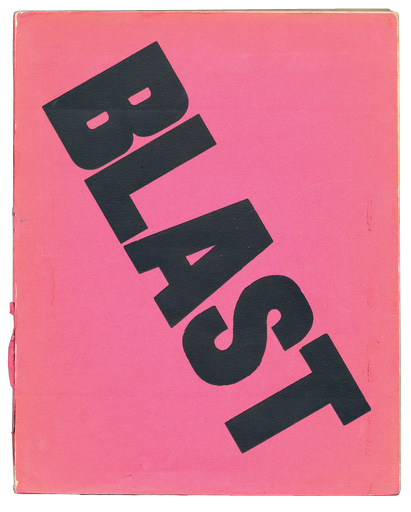BLAST magazine, the short lived publication of Wyndham Lewis may have singlehandedly began Modernism. Using blatant cover designs and revolutionizing art, the War killed off the vorticist movement which was only able to kick off two publications:


BLAST 1----------------- BLAST 2
Vorticism was defined in a manifesto contained within BLAST 1, published in 1914. It states many things, but basically:
In doing so, however, one is struck with the idea of a movement. The moment BLAST was published, World War I broke out. Utilizing age old adages of the glory of war as a "game," Britain was in for a series wake-up call. Art of the time, some of which was included in BLAST, would begin to echo British propaganda posters. The 1800s, marked as the Victorian Era, would take its toll on the British psyche. Tanks, colonial wars, bombs, technology, and industry would all begin to alter the world. Each movement attempted to articulate change in its own way, but BLAST did it most interestingly: by reacting to international European pressures. You can't budge us, we won't accept that, and we don't like you either.
These principles, and others made the movement inherently opposed to all others of the time. They are not about anything in particular, nor do they stand for anything. In a sense, the failures of Vorticism are inherently Vorticist, as they are an anti-movement it would make sense to have been short lived. In France and Spain, Cubism tended to be destructive, but it was followed by an immediate re-arrangement back to beauty. Italian Futurism went the energy route, absorbing the fast-paced nature of the present and speeding it along into the advancing future. The Vorticists centered themselves on a static admist a spinning vortex. All around them, Europe was grasping the reigns of culture, they simply identified themselves rather than creating any type of revolutionary movement.
- Beyond Action and Reaction we would establish ourselves.
- We start from opposite statements of a chosen world. Set up violent structure of adolescent clearness between two extremes.
- We discharge ourselves on both sides.
- We fight first on one side, then on the other, but always for the SAME cause, which is neither side or both sides and ours.
- Mercenaries were always the best troops.
- We are primitive Mercenaries in the Modern World.
- Our Cause is NO-MAN'S.
- We set Humor at Humor's throat. Stir up Civil War among peaceful apes.
- We only want Humor if it has fought like Tragedy.
- We only want Tragedy if it can clench its side-muscles like hands on its belly, and bring to the surface a laugh like a bomb.
In doing so, however, one is struck with the idea of a movement. The moment BLAST was published, World War I broke out. Utilizing age old adages of the glory of war as a "game," Britain was in for a series wake-up call. Art of the time, some of which was included in BLAST, would begin to echo British propaganda posters. The 1800s, marked as the Victorian Era, would take its toll on the British psyche. Tanks, colonial wars, bombs, technology, and industry would all begin to alter the world. Each movement attempted to articulate change in its own way, but BLAST did it most interestingly: by reacting to international European pressures. You can't budge us, we won't accept that, and we don't like you either.
